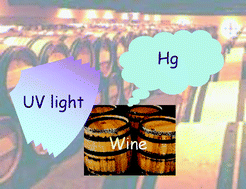A new and unique photo-induced mercury cold/chemical vapor generation (PI-CVG), which directly uses sample matrix as a reductant, was proposed for atomic fluorescence spectrometric detection of trace mercury in wine or liquor samples. The new method was thus termed as sample matrix-assisted PI-CVG. With the ultraviolet radiation (UV), the sample matrix (ethanol) can reduce mercury compounds or ions to atomic mercury, Hg0, which is subsequently swept (by argon carrier gas) into an atomic fluorescence spectrometer for the measurements. Under the optimized experimental conditions, the LOD for mercury was found to be 70 pg mL−1 with ethanol. The standard addition method was used for the real sample analysis to achieve the reagent free goal. The proposed method features high sensitivity, simplicity (no sample pre-treatment), rapidness, freedom of reagent (the sample matrix as the reductant), cost-effectiveness, and environmental cleanness. Indeed, this is the simplest approach to generate mercury vapor from alcohol-containing samples, and it is expected to have a wide application in the analysis of wines, liquors, and the like. Also, the PI-CVG can be coupled to other analytical atomic spectrometers.


 Please wait while we load your content...
Please wait while we load your content...